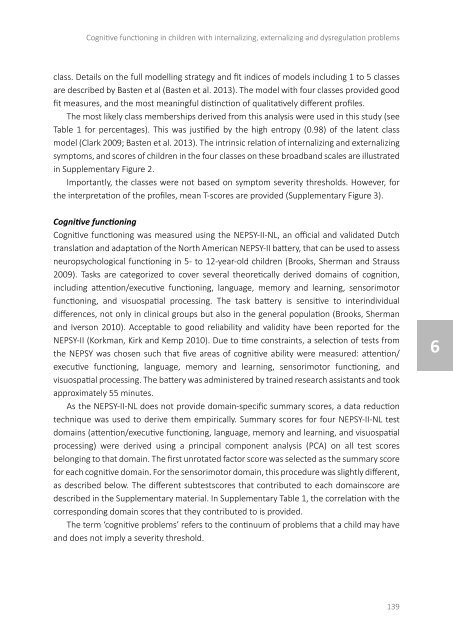On the Spectrum
2lm5UyR
2lm5UyR
You also want an ePaper? Increase the reach of your titles
YUMPU automatically turns print PDFs into web optimized ePapers that Google loves.
Cognitive functioning in children with internalizing, externalizing and dysregulation problems<br />
class. Details on <strong>the</strong> full modelling strategy and fit indices of models including 1 to 5 classes<br />
are described by Basten et al (Basten et al. 2013). The model with four classes provided good<br />
fit measures, and <strong>the</strong> most meaningful distinction of qualitatively different profiles.<br />
The most likely class memberships derived from this analysis were used in this study (see<br />
Table 1 for percentages). This was justified by <strong>the</strong> high entropy (0.98) of <strong>the</strong> latent class<br />
model (Clark 2009; Basten et al. 2013). The intrinsic relation of internalizing and externalizing<br />
symptoms, and scores of children in <strong>the</strong> four classes on <strong>the</strong>se broadband scales are illustrated<br />
in Supplementary Figure 2.<br />
Importantly, <strong>the</strong> classes were not based on symptom severity thresholds. However, for<br />
<strong>the</strong> interpretation of <strong>the</strong> profiles, mean T-scores are provided (Supplementary Figure 3).<br />
Cognitive functioning<br />
Cognitive functioning was measured using <strong>the</strong> NEPSY-II-NL, an official and validated Dutch<br />
translation and adaptation of <strong>the</strong> North American NEPSY-II battery, that can be used to assess<br />
neuropsychological functioning in 5- to 12-year-old children (Brooks, Sherman and Strauss<br />
2009). Tasks are categorized to cover several <strong>the</strong>oretically derived domains of cognition,<br />
including attention/executive functioning, language, memory and learning, sensorimotor<br />
functioning, and visuospatial processing. The task battery is sensitive to interindividual<br />
differences, not only in clinical groups but also in <strong>the</strong> general population (Brooks, Sherman<br />
and Iverson 2010). Acceptable to good reliability and validity have been reported for <strong>the</strong><br />
NEPSY-II (Korkman, Kirk and Kemp 2010). Due to time constraints, a selection of tests from<br />
<strong>the</strong> NEPSY was chosen such that five areas of cognitive ability were measured: attention/<br />
executive functioning, language, memory and learning, sensorimotor functioning, and<br />
visuospatial processing. The battery was administered by trained research assistants and took<br />
approximately 55 minutes.<br />
As <strong>the</strong> NEPSY-II-NL does not provide domain-specific summary scores, a data reduction<br />
technique was used to derive <strong>the</strong>m empirically. Summary scores for four NEPSY-II-NL test<br />
domains (attention/executive functioning, language, memory and learning, and visuospatial<br />
processing) were derived using a principal component analysis (PCA) on all test scores<br />
belonging to that domain. The first unrotated factor score was selected as <strong>the</strong> summary score<br />
for each cognitive domain. For <strong>the</strong> sensorimotor domain, this procedure was slightly different,<br />
as described below. The different subtestscores that contributed to each domainscore are<br />
described in <strong>the</strong> Supplementary material. In Supplementary Table 1, <strong>the</strong> correlation with <strong>the</strong><br />
corresponding domain scores that <strong>the</strong>y contributed to is provided.<br />
The term ‘cognitive problems’ refers to <strong>the</strong> continuum of problems that a child may have<br />
and does not imply a severity threshold.<br />
6<br />
139


